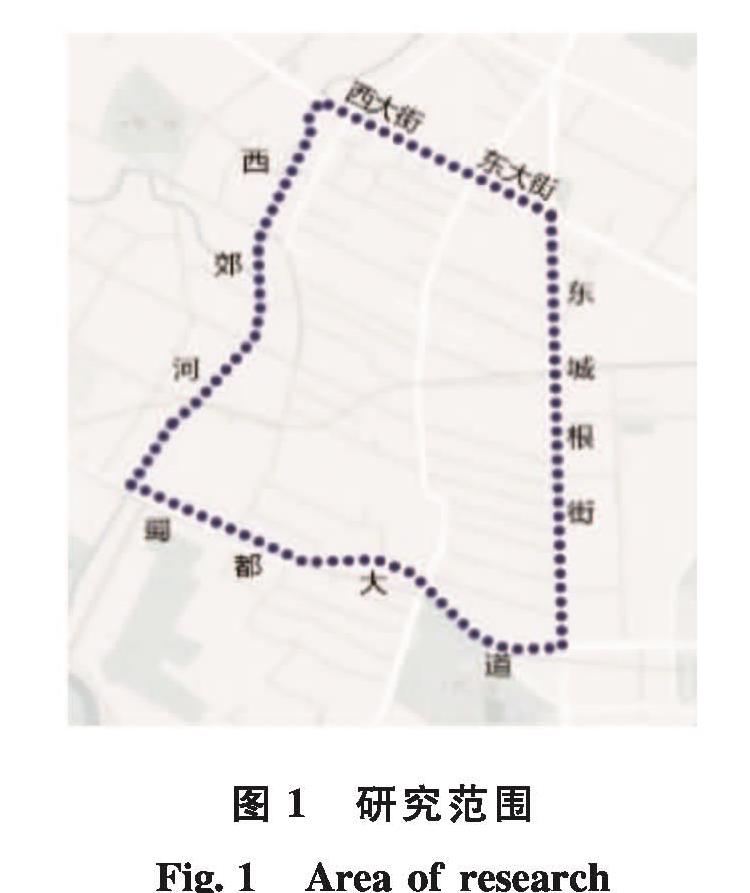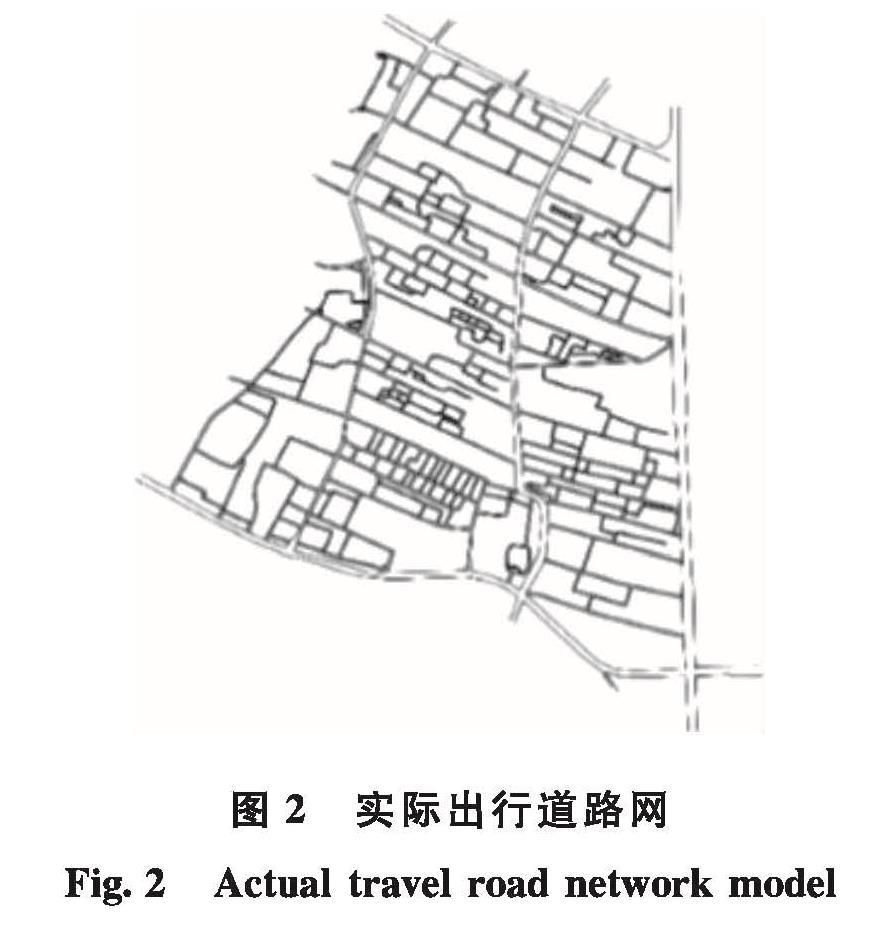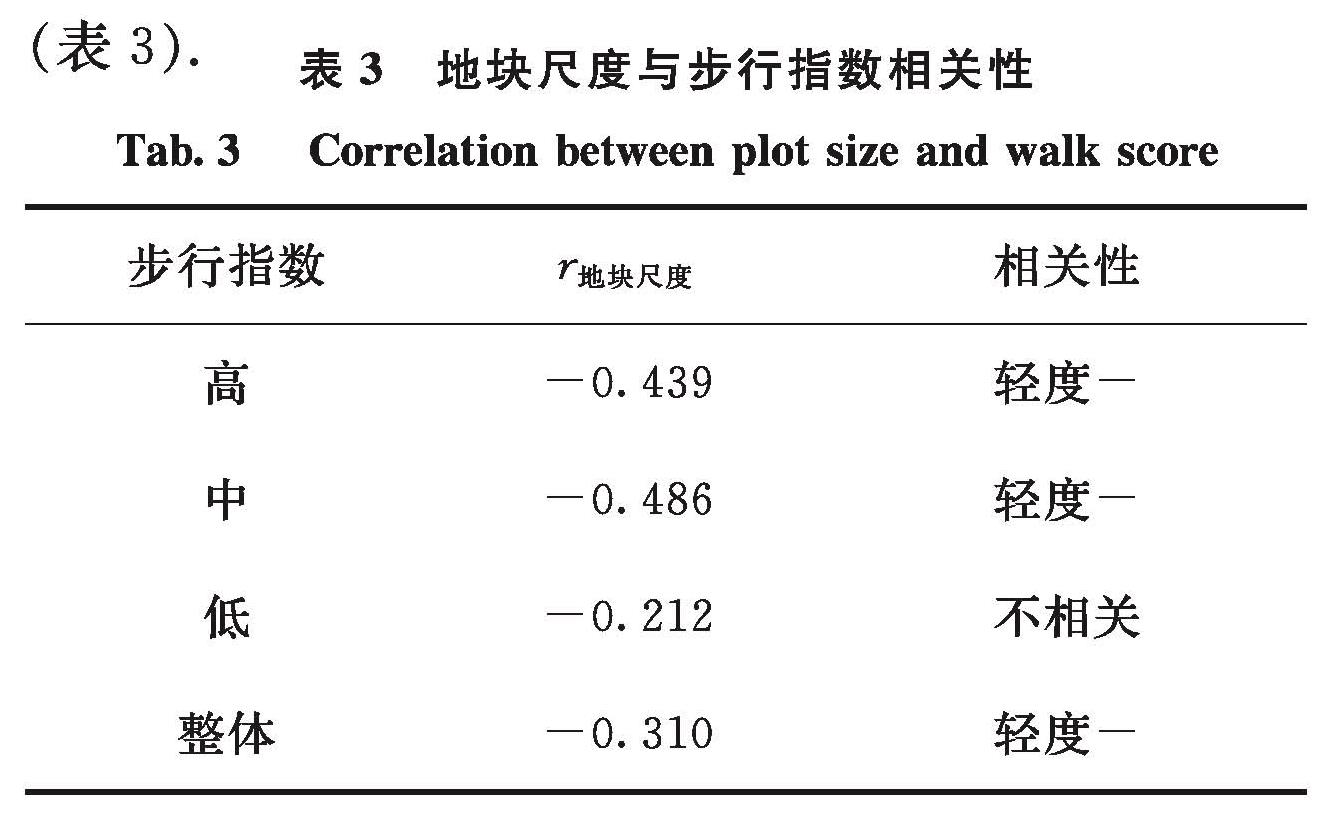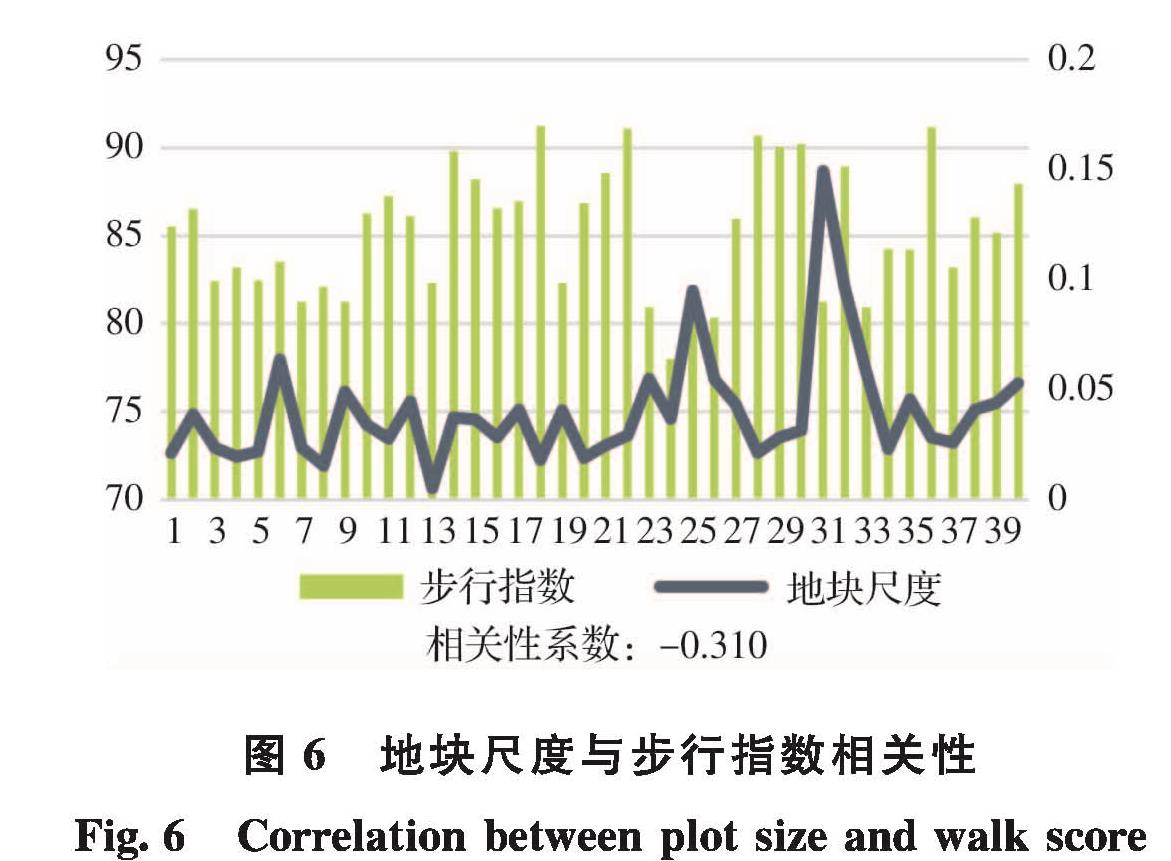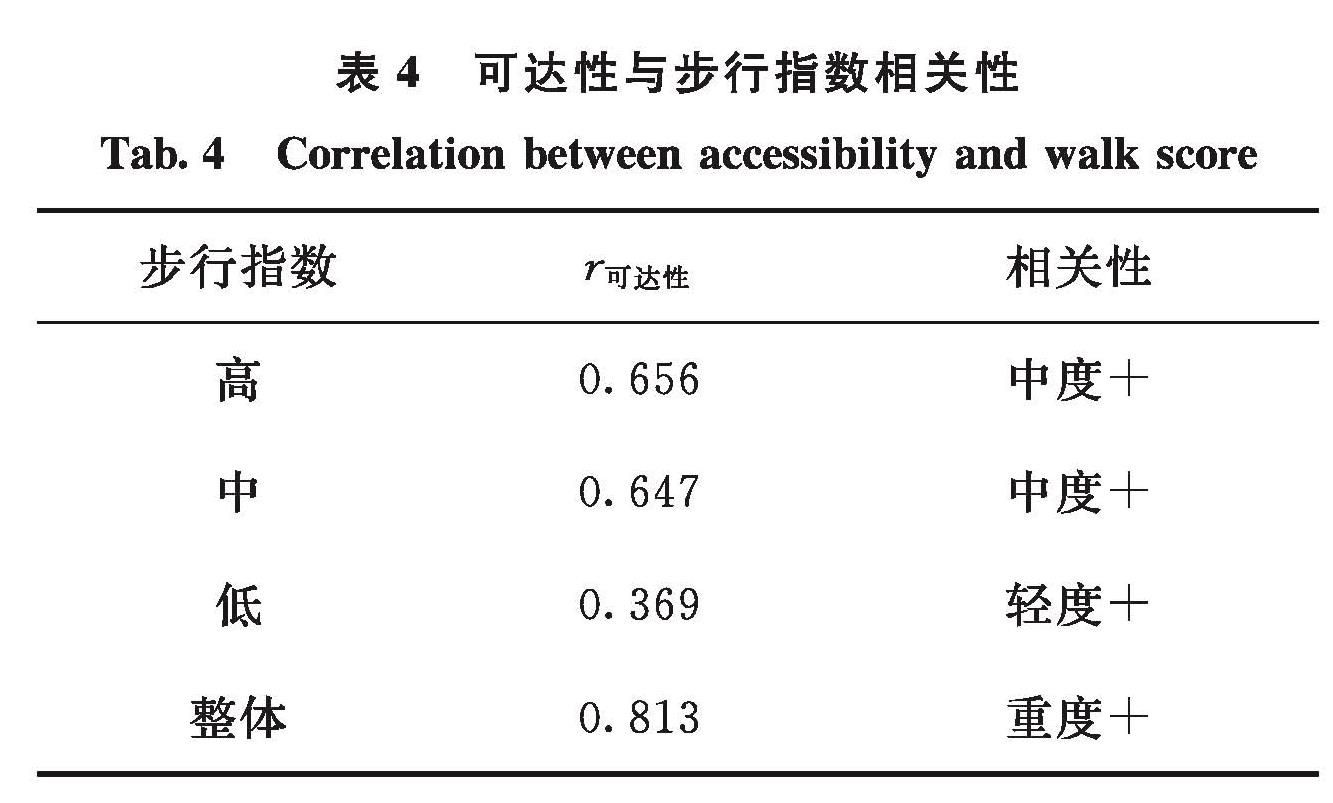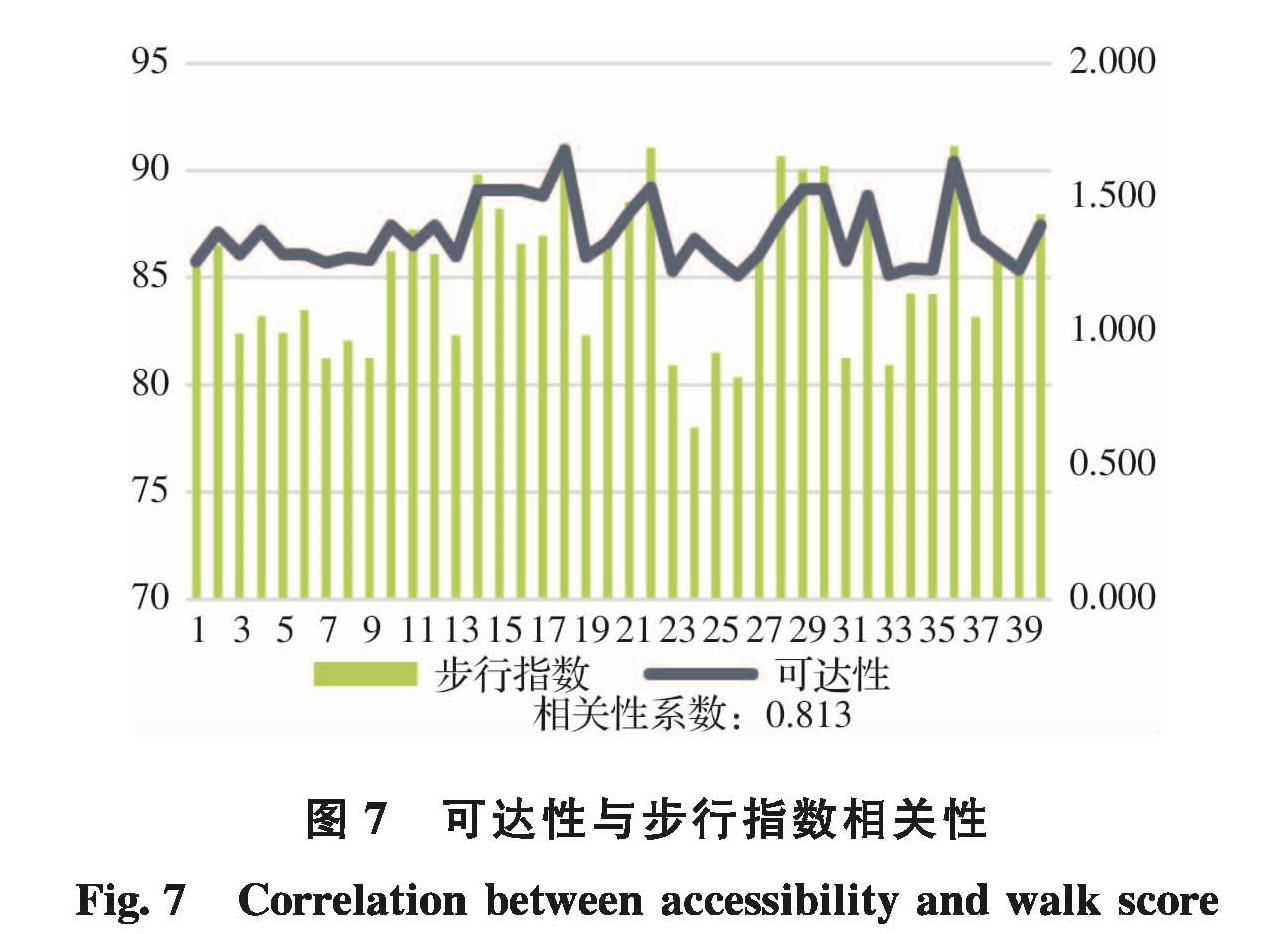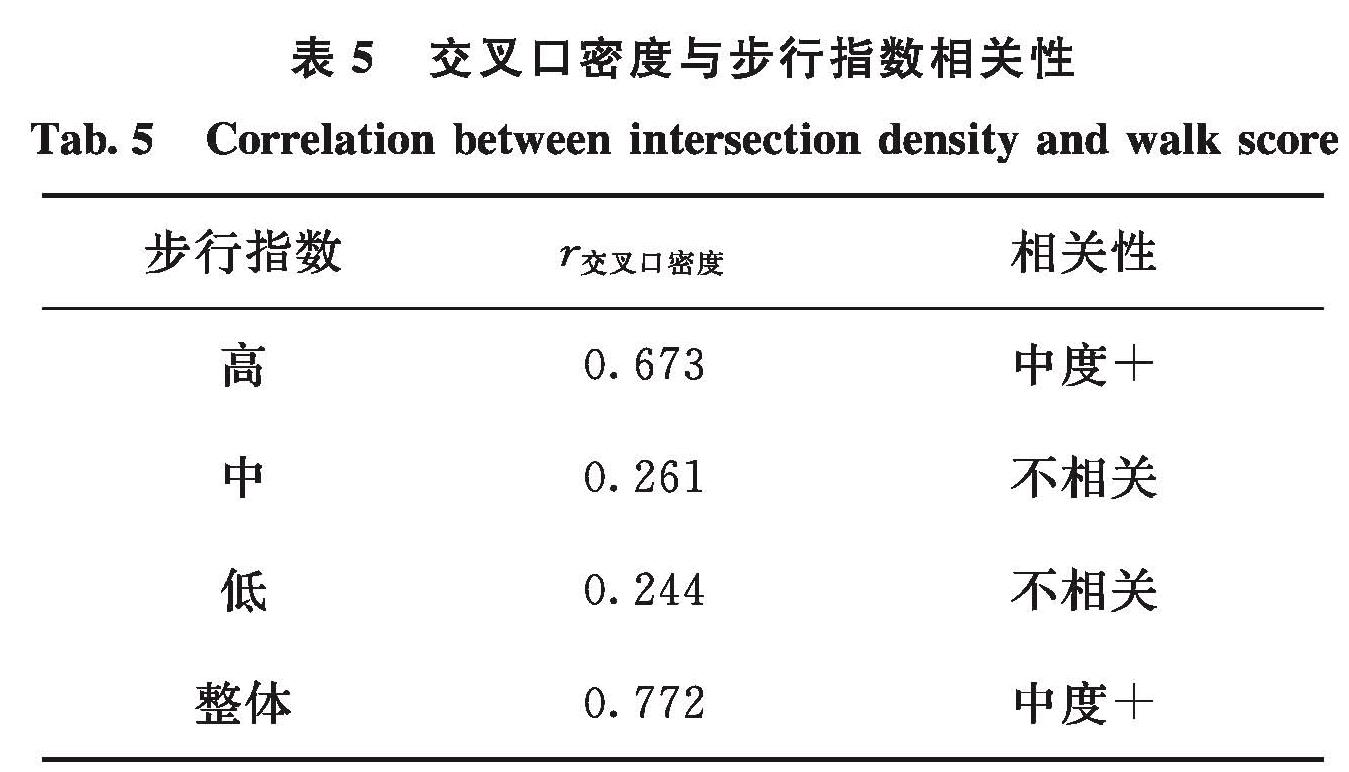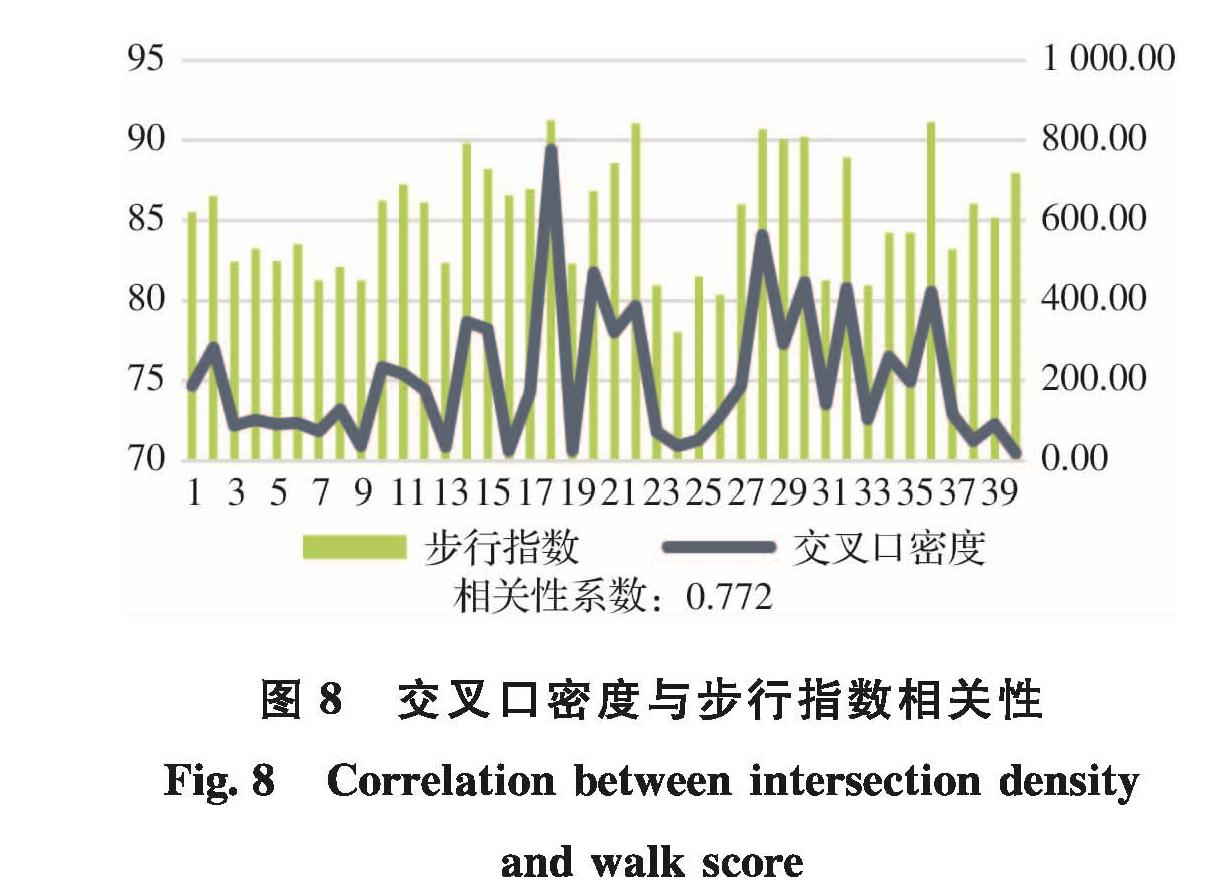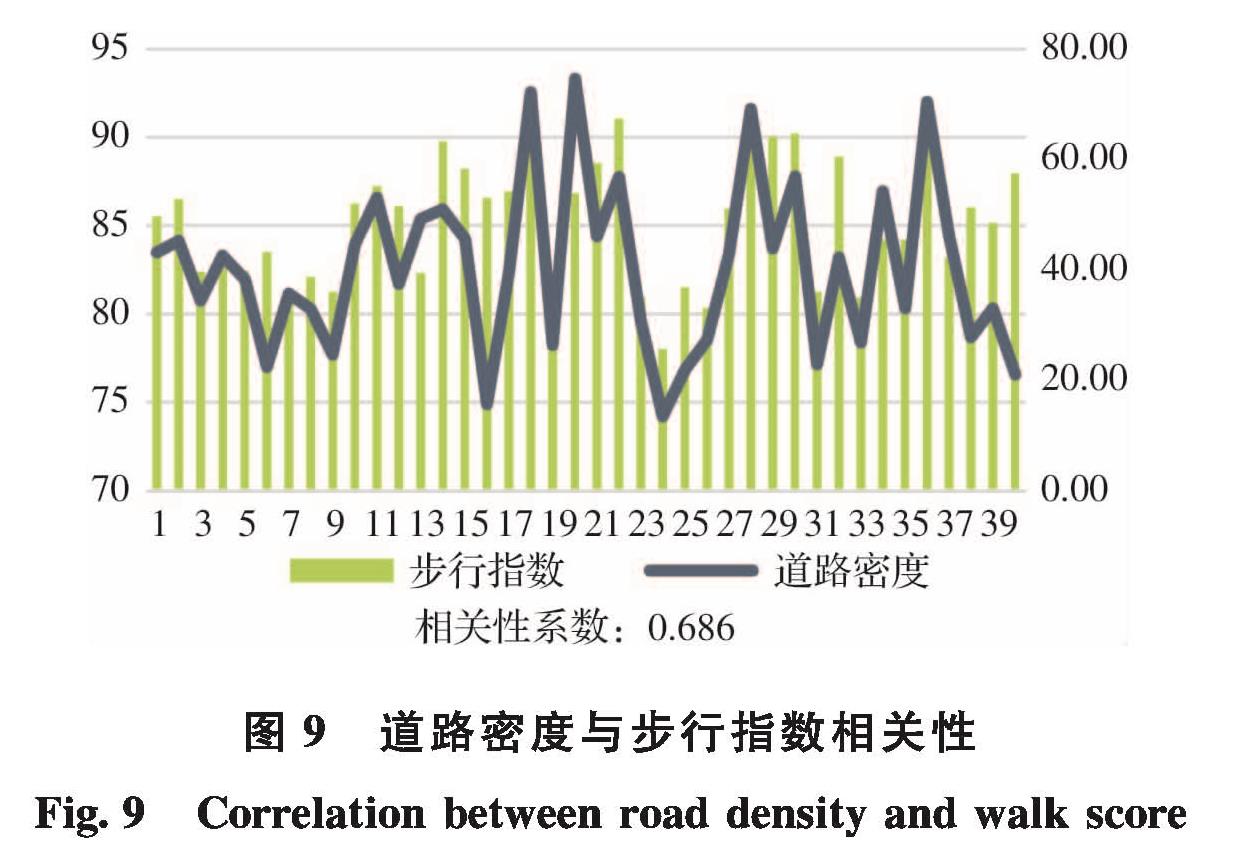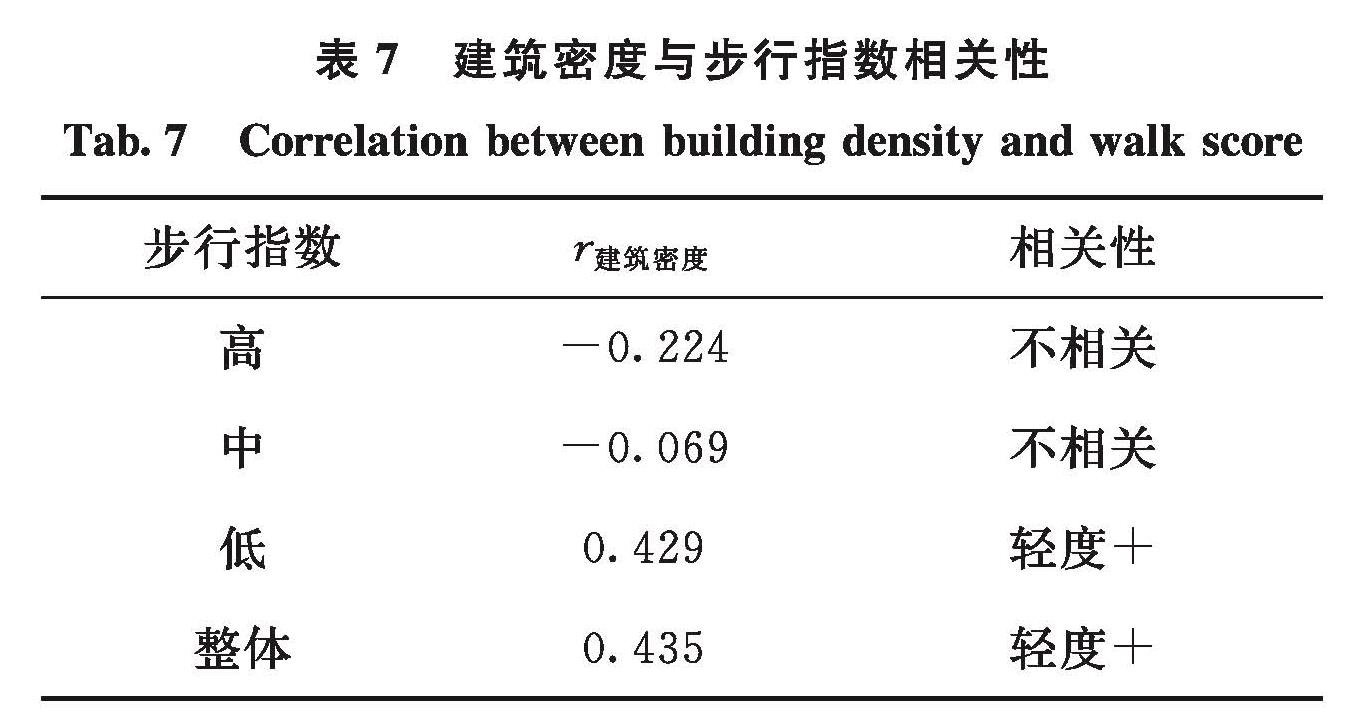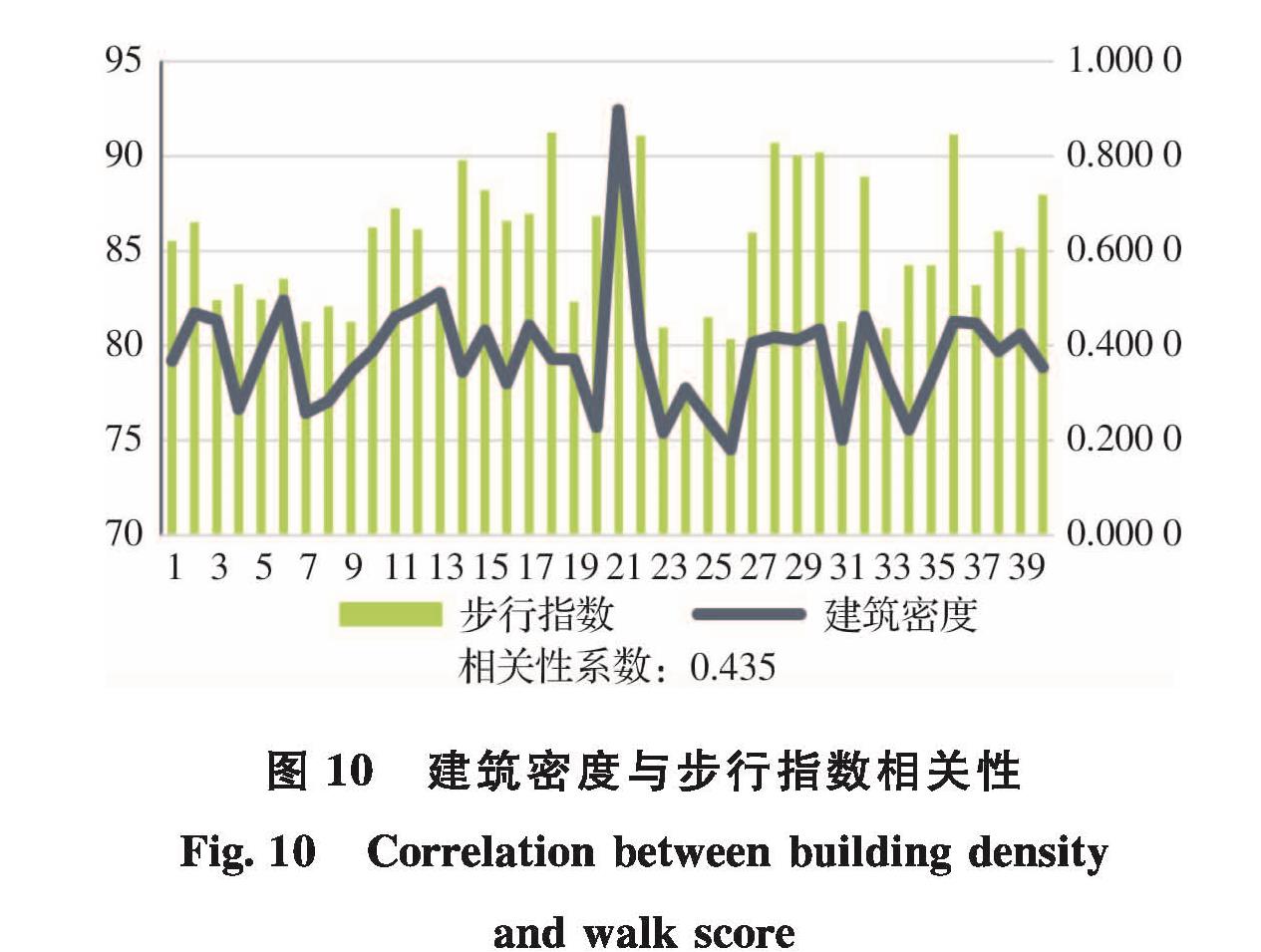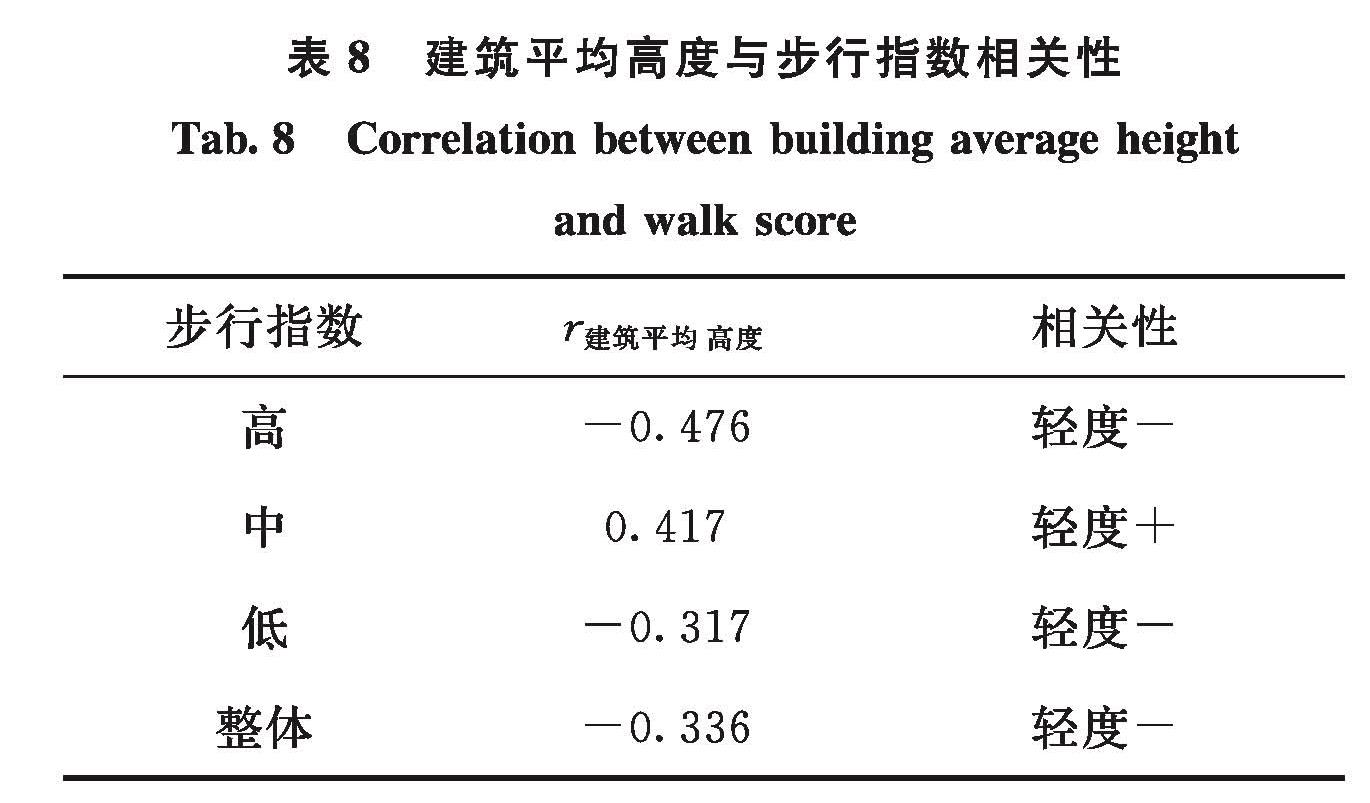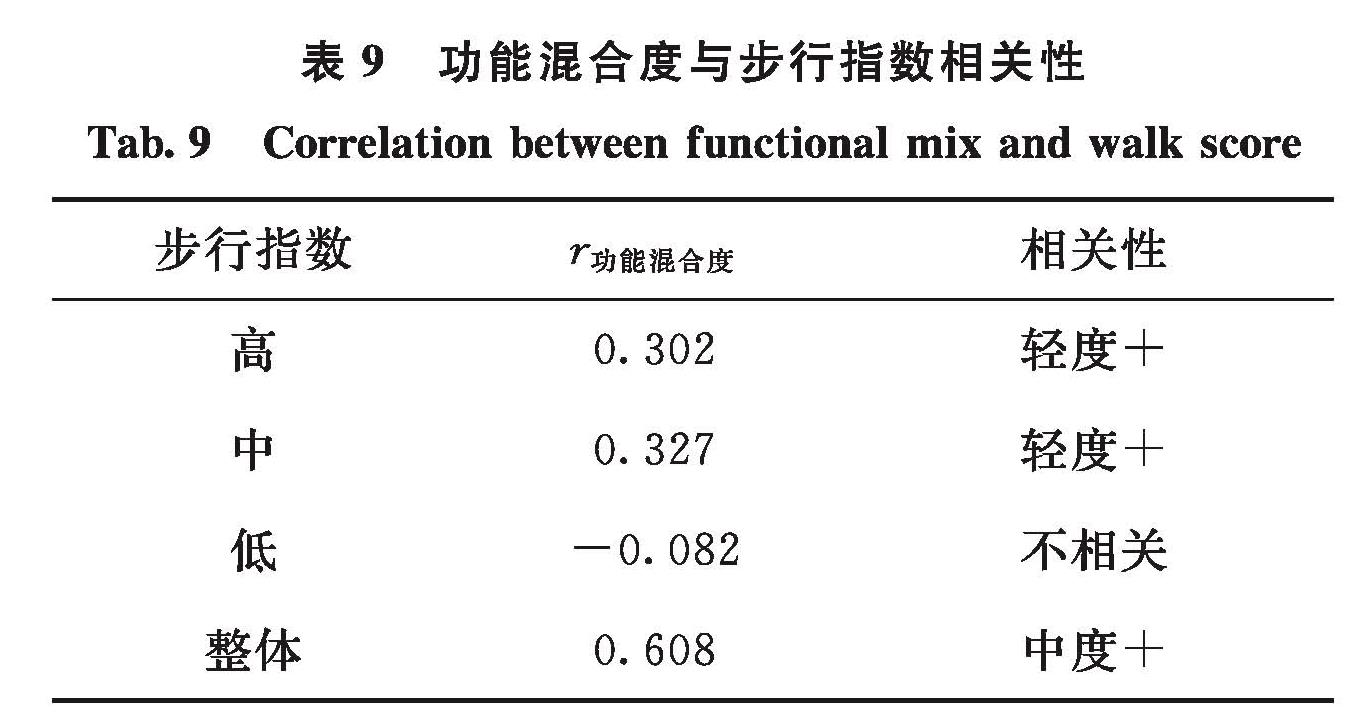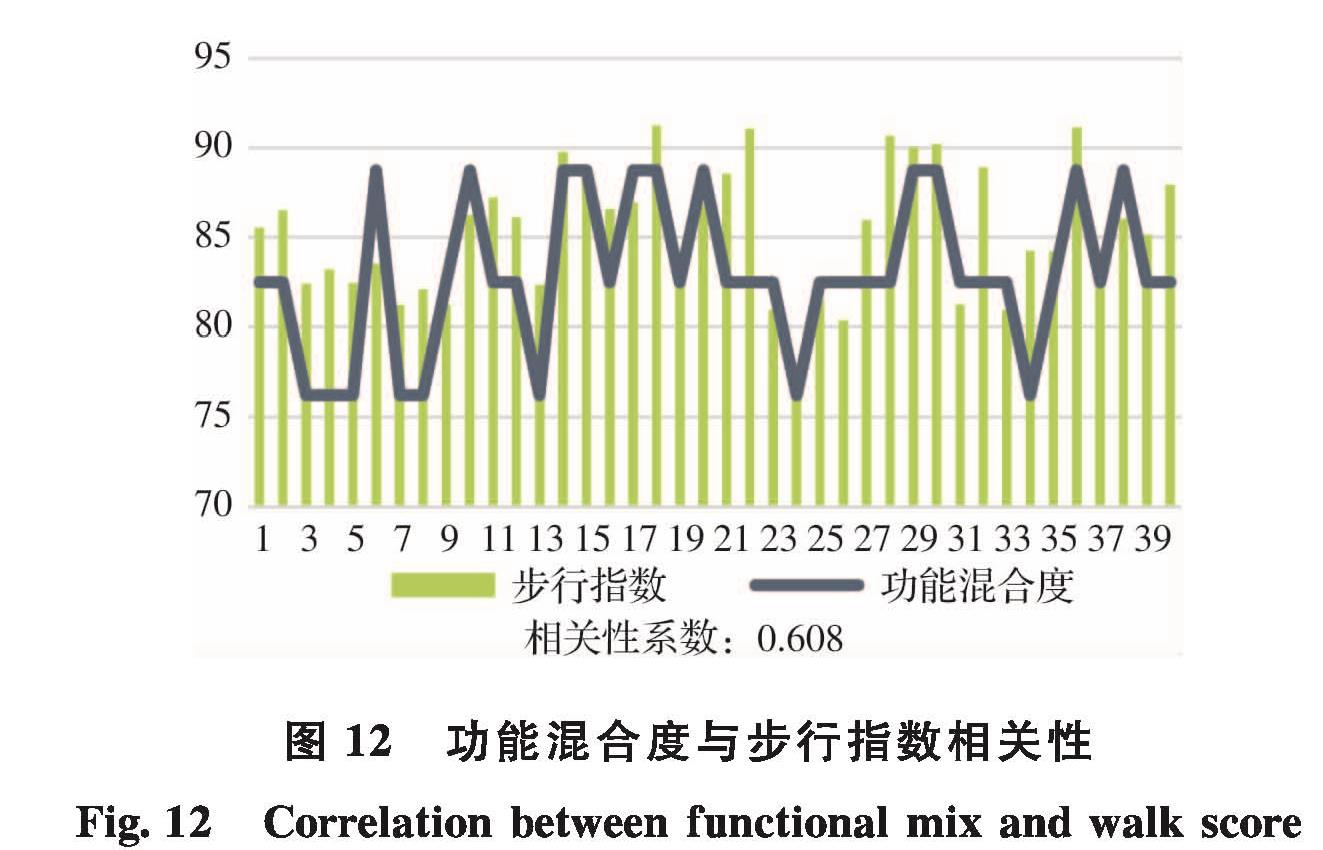第一作者:吉雪梅(1995-),女,硕士生,主要从事当代城市设计理论研究.E-mail:xuemei0819ji@163.com 通讯作者:张鲲(1966-),男,教授,硕士,主要从事当代城市设计理论研究.E-mail:ackun@126.com
(School of Architecture and Environment, Sichuan University, Chengdu 610000,China)
walkability; urban spatial morphology; quantitative analysis; walk score; corvrelation
DOI: 10.15986-j.1006-7930.2020.04.014
备注
第一作者:吉雪梅(1995-),女,硕士生,主要从事当代城市设计理论研究.E-mail:xuemei0819ji@163.com 通讯作者:张鲲(1966-),男,教授,硕士,主要从事当代城市设计理论研究.E-mail:ackun@126.com
步行作为一种低碳绿色的出行方式,在城市交通、环境、活力、健康等问题上起着重要的改善作用.本文选取成都市少城片区作为研究对象,定量分析了可步行性与城市空间形态之间的关系,将地块尺度、交叉口密度、道路密度、建筑平均高度与Form Syntax方法中的街道可达性、建筑密度、功能混合度结合作为城市空间形态指标,并运用步行指数方法计算了可步行性.结果显示,各指标对可步行性影响从大到小依次为:可达性、交叉口密度、道路密度、功能混合度、建筑密度、建筑平均高度、地块尺度,其中地块尺度和建筑平均高度呈负相关,其余呈正相关.研究指出提高可步行性可从城市空间形态指标的定量设计入手,为健康步行城市的建设提供了参考.
As a low-carbon and green travel mode, walking plays an important role in improving transportation, environment, vitality, and health of cities. This article selects the Shaocheng area of Chengdu as the research object, and quantitatively analyzes the relationship between walkability and urban spatial form. The plot size, intersection density, road density, building average height and street availability, building density, functional mix in Form Syntax constitute urban spatial form indicators. And walkability was calculated by using Walk Score. Result shows that the impact of various indicators on walkability in descending order is: accessibility, intersection density, road density, functional mix, building density, average building height, and plot size, of which plot size and building average height are negatively correlated, and the rest are positively correlated. The study indicates that improving walkability could start from the quantitative design of urban spatial morphological indicators, which provides a reference for the construction of a healthy walking city.
引言
2019年,交通运输部等十二部门和单位提出要优化城市道路网络配置,加大步行道的建设力度,保障行人合理的通行空间[1].步行作为一种低碳绿色的出行方式,在城市交通、环境、活力、健康等问题上起着重要的改善作用.
上个世纪90年代末,美国最早提出了可步行性的概念,其涵盖了与步行交通相关的建成环境维度[2].可步行性作为一个建成环境的评价指标,反应了街道的可达性、交叉口密度、道路密度、建筑密度、功能混合度等建成环境特征.卢银桃等认为可步行性是一种空间属性,体现了空间对居民出行的引导能力,即建成环境对步行的支持程度和步行者在环境中的步行体验[3].目前研究表明可步行性的高低与街道可达性及连通性、土地利用密度及功能混合度、日常生活设施的数量等因素有关[4].由此,可步行性的空间属性与城市空间形态密切相关,但目前还未有研究对可步行性和城市空间形态之间关系进行定量分析.
2007年,步行指数在美国产生,是一种公开的、广范围计算的可步行性量化指标.其运算法则是基于日常生活服务设施的种类和空间布局,再通过交叉口密度、街区长度、步行距离等因素进行修正[5].龙瀛等学者将步行指数引入国内,对指标进行筛选和本土化,在不同尺度上评价了中国城市的步行指数现状[6].Form Syntax是香港大学和荷兰代尔夫特大学的学者从2014年逐步提出与发展的一种基于街区的街道、建筑形态和功能混合等与城市空间形态相关的全面量化分析方法 [7-8].
本文基于步行指数和Form Syntax,对指标体系、权重设置和修正系数等进行本土化调整,定量探究了地块尺度、街道可达性、交叉口密度、道路密度、建筑密度、建筑平均高度、功能混合度与可步行性之间的关系,以期建立可步行性的城市空间形态评价体系,为以后的步行健康城市建设提供参考.
1 研究范围与数据
1.1 研究范围本文研究范围位于成都市少城片区,市中心天府广场以西,北至西大街、八宝街,南至蜀道大道,东至东城根街,西至西郊河,总面积约为1.5 km2(图1).我国大多数古城的道路呈现围棋状,但少城却呈现出一种独特的“鱼骨状”道路布局,同仁路、长顺街、东城根街等组成南北向的道路框架,将军街、宽窄巷子、实业街等街道将东西串联,共同形成了其独特的道路布局.2016年成都市居民出行调查结果表明,中心城区步行的出行比例占32.7%,是最主要的慢行交通方式[9],少城片区的步行行为发生频率高.
1.2 研究数据本文的基础研究数据包括地图兴趣点、路网数据、建设强度基础数据.兴趣点数据由大型地图网站进行网络爬虫获得,根据步行指数的指标筛选兴趣点,建立与日常生活相关的服务设施数据库,包括名称、地理位置、类别、地址等信息.路网数据从地图上获取,在CAD软件中绘制平面图,精细到小的步行通道,并通过实地调研确定实际的道路网络.随后将制图得到的道路模型进行地理坐标的转换,与兴趣点使用同一地理坐标系,得到实际居民出行道路模型(图2).建设强度基础数据来自于地图数据,通过Autocad软件对少城片区的平面进行绘制,统计出地块的面积、交叉口个数、道路长度、建筑底面积、建筑总面积等作为基础数据.
2 研究方法
3 研究结果
3.1 步行指数根据上述步行指数的研究方法,利用自然间断点分级法将分数分为6个等级,得到了少城片区的面域步行指数(图4).结果显示,步行指数最高分是94.11分,最低分76.03分,平均84.53分,按照步行指数的评分标准,少城片区非常适合步行,即在少城片区大多数的日常出行通过步行便可达到.随后基于面积权重计算了各地块的步行指数,利用自然间断点分级法将其分为高中低三类,图5(a).结果显示,步行指数为高等级的地块有12个,中等级的有16个,低等级的地块有12个,其中最低分为78.02,最高分为91.25,平均分为85.29.
3.2 城市形态在第三部分中得到了地块尺度、街道可达性、交叉口密度、道路密度、建筑密度、建筑平均高度、功能混合度的定量分析数据,图5为将其通过Arcgis中的自然间断点分级法进行高中低的图示表现.
本文整理了少城片区内地块面积,将结果分为高中低三个等级,图5(b),可以得出以下特征:少城片区地块面积0.005~0.150 km2不等,最大面积与最小面积相差30倍,但大多以0.03~0.09 km2为主.
将Anxwomen插件得到的街道全局整合度赋予其包括的地块,并根据自然断点法将地块可达性分为高中低三个等级,图5(c).结果显示,可达性等级高的地块有13个、中等级的有19个、低等级的有8个,占比分别为32.5%、47.5%、20%.少城片区地块可达性大部分为中、高等级,整个片区的可达性较为稳定,且可达性高的地块多位于十字路口、面积中等且地块内道路较多的区域.
道路的交叉使得片区内形成约303个路口,十字路口53个,三叉路口250个.通过计算各地块的交叉口密度,并运用自然断点法得到交叉口密度高中低三个层次的图示表现,图5(d).结果显示,交叉口密度等级高的地块有7个、中等级的有13个、低等级的有20个.步行指数高的地块内岔路口较为密集,居民可以快捷地到达街道,并快速到达目的地.
图5(e)为地块道路密度高中低三个层次的图示表现.结果显示,道路密度等级高的地块有8个、中等级有20个、低等级有12个,占比分别为20%、50%、30%.片区内道路密度等级大部分为中等级,而高等级和低等级的地块数量较为平均.
基图5(f)为地块建筑密度高中低三个层次的图示表现.结果显示,建筑密度高等级的地块有10个,中等级有19个,低等级有11个.多数的地块的建筑密度为中等级,这保证了建筑与街道空间的相互渗透,提高了步行行为发生的可能性.
在研究片区内计算了各地块的建筑平均高度,图5(g)为通过ARCGIS分成高中低三个层次的图示表现.结果显示,建筑平均高度为高等级的地块有14个,中等级有19个,低等级有7个,大部分地块的建筑平均高度处于中、高等级.图5(h)为按照高(混合功能)、中(双功能)、低(单一功能)将40个地块的功能混合度在地块尺度上的呈现.结果显示,高等级的地块有9个,中等级有22个,低等级有9个.大部分地块处于中、高等级,占比77.5%,其中单一功能地块均为纯住宅区.
3.3 相关性分析本文将地块步行指数与地块尺度、可达性、交叉口密度、道路密度、建筑密度、建筑平均高度、功能混合度进行了相关性分析.拟定相关性系数r的绝对值在0~0.3为不相关,0.3~0.5为轻度相关,0.5~0.8为中度相关,0.8~1为重度相关,用+表示正相关,用-表示负相关[15].分析结果如下:
地块尺度与步行指数的相关性系数为-0.310,为轻度负相关(图6).高步行指数中与地块尺度呈现轻度负相关,低步行指数与地块尺度不相关(表3).
可达性与步行指数的相关性系数为0.813,为重度正相关(图7).当步行指数处于中、高等级时,可达性越大,步行指数越高,但可达性对低等级步行指数影响较小(表4). 交叉口密度与步行指数的相关性系数为0.772,为中度正相关(图8).当步行指数处于高等级时,交叉口密度对步行指数的影响显著,当步行指数处于中、低水平时,交叉口密度和步行指数不相关(表5). 道路密度与步行指数的相关性系数为0.686,为中度正相关(图9),其与步行指数在高中低三个等级均为中度正影响,表现一致(表6). 建筑密度与步行指数的相关性系数为0.435,为轻度正相关(图 10).当步行指数较低时,建筑密度对步行指数是中度正影响.当步行指数处于高等级,建筑密度对步行指数产生轻度负影响(表7).
建筑平均高度与步行指数的相关性系数为-0.312,为轻度负相关(图 11).当步行指数处于两极(高低)时,建筑平均高度的影响是消极的,当步行指数处于中等级时,建筑平均高度能促进步行指数的提高(表8). 功能混合度与步行指数的相关性系数为0.608,为中度正相关(图 12).中、高等级步行指数与功能混合呈现轻度正相关,低等级步行指数与功能混合度不相关(表9). 根据上述结果,按各指标与可步行性整体相关性系数的绝对值大小进行排列,整理得到城市空间形态指标与可步行性的相关性表(表 10).4 结论
基于城市空间形态,本文对可步行性进行了定量分析,可得出以下结论:
(1)城市空间形态指标体系包括可达性、交叉口密度、道路密度、功能混合度、建筑密度、建筑高度以及地块尺度,高可步行性是所有指标综合作用的结果,而各指标对可步行性影响从大到小依次为:可达性、交叉口密度、道路密度、功能混合度、建筑密度、建筑平均高度、地块尺度,其中地块尺度和建筑平均高度为轻度负相关,可达性为重度正相关,其余为中度正相关.
(2)从各指标的高中低三个层次来看,道路网越密,交叉口越多,可增加居民步行的路径选择,进而可达性越高,可步行性越高; 功能混合越丰富,则居民活动形式越多,可增加可步行性; 一定范围内建筑密度越高,步行行为发生频率越高,可步行性越高,但高建筑密度却对高可步行性有抑制作用; 建筑平均高度和地块尺度的提升使可步行性降低,但适当提高建筑高度可实现中等可步行性
(3)基于前文的分析,从城市空间形态角度优化城市步行环境和提高可步行性的建议有:①增加=道路道路交叉口,增强道路网络连通性,减低街区尺度,构建可达性高的步行网络结构; ②保持适宜的建筑密度,控制建筑的高度,优化建筑功能的空间布局,提供足够的功能混合度.
(4)本文通过选取少城片区,从理论研究的角度分析了城市空间形态与可步行性的关系,未来仍需要更多实测研究,但本研究为建设步行健康城市提供了参考方向:促进城市可步行性可从足够的交叉口密度、道路密度与功能混合度以及良好的可达性、适宜的地块尺度、建设密度与建筑高度方面入手,将这些空间形态要素在同一空间集聚,城市的可步行性将会提升.
- [1] 中华人民共和国交通运输部. 交通运输部等十二部门和单位关于印发绿色出行行动计划(2019—2022年)的通知[ER/OL]. [2019-05-31]. http://xxgk. mot.gov.cn/jigou/ysfws/201905/t20190531_3207748.html.
- [2] CERVERO R, KOCKELMAN K. Travel demand and the three ds: Density, diversity, and design[J]. Transportation Research Part D: Transport and Environment, 1997, 2(3): 199-219.
- [3] 卢银桃,王德.美国步行性测度研究进展及其启示[J]. 国际城市规划,2012,27(1):10-15.
- [4] LO R H. Walkability: What is it?[J]. Journal of Urbanism: International Research on Placemaking and Urban Sustainability. 2009, 2(2): 145-166.
- [5] Walk Score.Walk Score Methodology[EB/OL]. [2018-03-9]. http://www.walkscore.com/methodology. shtml.
- [6] 龙瀛,赵健婷,李双金,等.中国主要城市街道步行指数的大规模测度[J]. 新建筑,2018(3):4-8.
- [7] Y Ye Y, Van Nes A. Quantitative tools in urban morphology: Combining space syntax, spacematrix, and mixed-use index in a GIS framework[J]. Urban Morphology, 2014, 18(2): 9.
- [8] 叶宇,庄宇.城市形态学中量化分析方法的涌现[J]. 城市设计,2016(4):56-65.
- [9] 周垠,李果.15分钟步行圈生活便利指数评价与区县比较——以成都市中心城区为例[J]. 上海城市规划,2018(5):78-82.
- [10]芦原义信. 外部空间设计[M]. 北京:中国建筑工业出版社, 1985.
- [11]HILLIER B, HANSON J. The social logic of space[M]. Cambridge: Cambridge University Press, 1984.
- [12]范科红,李阳兵,冯永丽.基于GIS的重庆市道路密度的空间分异[J]. 地理科学,2011,31(3):365-371.
- [13]PONT M B, HAUPT P. Spacematrix: Space, density and urban form[M]. Rotterdam: Nai Publishers, 2010.
- [14]Van den Hoek J. The MXI(Mixed-use Index)as planning tool for new towns in the 21st century[M]//Provoost M. New towns for the 21st century: The planned vs. the unplanned city. Amsterdam: SUN Architecture, 2009.
- [15]何晓群,刘文卿. 北京:应用回归分析[M]. 北京:中国人民大学出版社, 2019.
2.1 地块为了确保结果的一致性,本文将地块作为基本分析单元,按照车行道路将区域划为40个地块(图3),将步行指数作为可步行性的定量表征,在地块尺度上定量分析可步行性与城市空间形态(地块尺度、可达性、交叉口密度、道路密度、建筑密度、建筑平均高度、功能混合度)之间的关系.
2.2 步行指数2.2.1 设施分类及权重本研究根据Walk Score日常生活服务设施的分类标准及权重赋值方法,对兴趣点数据进行分类,并将本土生活习惯因素考虑在内,例如将茶馆考虑在内,共划分为便利店、餐饮、茶馆和咖啡店等11种类型(表1).此外,研究中不仅考虑了设施种类的多样,也将设施的密度纳入考虑,对于餐饮、茶馆和咖啡店、商店及休闲娱乐设施依据距离的远近赋予了不同的权重.
2.2.2 单点步行指数日常生活设施数据(兴趣点)与路网结构通过地理坐标系的转换结合得到研究区域的网络数据.将研究区域划分为100 m×100 m的网格,根据步行指数方法计算每个网格中心点的基础步行指数.本研究将步行的最大距离设置为1 200 m,在此距离阈值内,距离越远,设施服务水平的衰减系数越大.为了便于计算,距离衰减系数采用分段函数:设施距离样本点在400 m内无衰减,400~800 m内衰减40%,800~1 200 m内衰减60%,超过1 200 m的设施不予考虑.单点步行指数计算公式如下.
W=∑n,nji=1,j=1Yij×Qj(1)
其中:W为单点步行指数; n为日常生活服务设施分; j为某类日常生活服务设施,取值为1~11; nj为对于设施j的设施多样性取值; Yij为对于设施j的第i个设施所对应的距离衰减系数; Qj为设施j的第i个设施的多样性权重值.
计算基础步行指数所采用的距离是直线距离,这与实际出行存在出入,因此需对基础步行指数进行修正,本文依据步行指数的计算方法将交叉口密度和街区长度作为修正因子,具体修正系数如表2所示.
2.2.3 面域步行指数上述方法是对单个点的步行指数进行测算,但要表现一个区域的可步行性则要计算面域步行指数.本文将修正后的168个单点步行指数导入Arcmap中,采用反重力距离法进行步行指数的插值,得到研究范围内的面域步行指数.
2.3 城市空间形态分析本文将地块尺度、交叉口密度、道路密度、建筑平均高度与Form Syntax方法中的街道可达性、建筑密度、功能混合度结合作为城市空间形态指标.
2.3.1 地块尺度“尺度是人类自身衡量客观世界和主观世界相关关系的一种准则”[10].本文通过地块面积的大小来探究地块尺度对可步行性的影响.
2.3.2 可达性空间句法由伦敦大学的Bill Hillier提出,是一种通过拓扑分析对空间结构进行量化的分析方法,可以分析空间的可达性[11].本研究基于空间句法的轴线分析对区域内的可达性进行分析,通过轴线的空间可达性进行拓扑分析,进而体现街道的可达性.全局整合度能体现某一轴线与其他轴线的离散或聚集关系,虽然连接值和平均深度值也能体现空间可达性,但其结果易受到轴线数量的影响,故本研究用全局整合度来分析空间可达性.将绘制好的轴线图通过Arcgis中的Anxwomen插件进行轴线分析,得到少城片区的全局整合度分布图,通过距离衰减模型实现可达性由线向面的转变.
2.3.3 交叉口密度道路纵横交错形成交叉口,给行人提供了多个到达目的地的可选途径.本文通过地块内交叉口的密度(交叉口个数/面积)来探究交叉口对可步行性的影响,并将结果通过Arcgis进行图示表现.
2.3.4 道路密度道路密度表示空间结构内单位面积的街道长度,反映路网疏密程度,其值越大,交通联系越便捷,而道道路密度过小,使居民出行时间增加[12].路网作为交通骨架连接了步行行为的起止点,其结构影响着城市的流动性.因此本文通过道路密度(区域内所有的道路的总长度与区域总面积之比)来探究道路密度与可步行性之间的定量关系.
2.3.5 建筑密度Form syntax方法中的Spacematrix(空间矩阵)由Berghauser Pont提出,是对于建筑形态和建设强度进行定量分析的方法[13].Spacematrix利用一系列密度数据来表现建设强度和建筑形态.足够的建筑密度在一定程度上保证了建筑与街道的渗透与交互,可提高步行行为发生的可能性,所以本研究选取密度数据中的建筑密度(建筑底面积与地块面积的比值)来探究其对可步行性的影响.
2.3.6 建筑平均高度建筑密度从平面的角度反映可步行性,建筑平均高度则是从竖向角度反映可步行性.步行者行走在街道与建筑形成的城市空间中,其心理感知被建筑高度所影响.本文计算地块内建筑的平均高度,来定量探析建筑高度与可步行性的关系,公式为
h=∑ni=1hi×(si)/(∑si)(2)
其中:h为建筑平均高度; n为地块内建筑数量; hi为建筑i的高度; si为建筑i的建筑总面积.
2.3.7 功能混合度基于步行尺度下的地块混合度,Van den Hoek J提出功能混合指标(MXI)方法[14].本文通过地块内居住(Dd)、工作(Wd)、设施(Fd)三种功能的建筑面积比值来划定功能混合度的高低,公式如下,并根据每种功能的楼层面积比率将地块分为三种类型:单一功能(某种功能面积比率>95%)、双功能(两种功能面积比率>5%)、混合功能(三种功能面积比率均>5%).
MXI=(%Dd)/(%Wd×%Fd)(3)
其中:MXI为功能混合度; Dd为各类以居住为功能的建筑面积; Wd为各类以工作为功能的建筑面积; Fd为各类以设施为功能的建筑面积.
